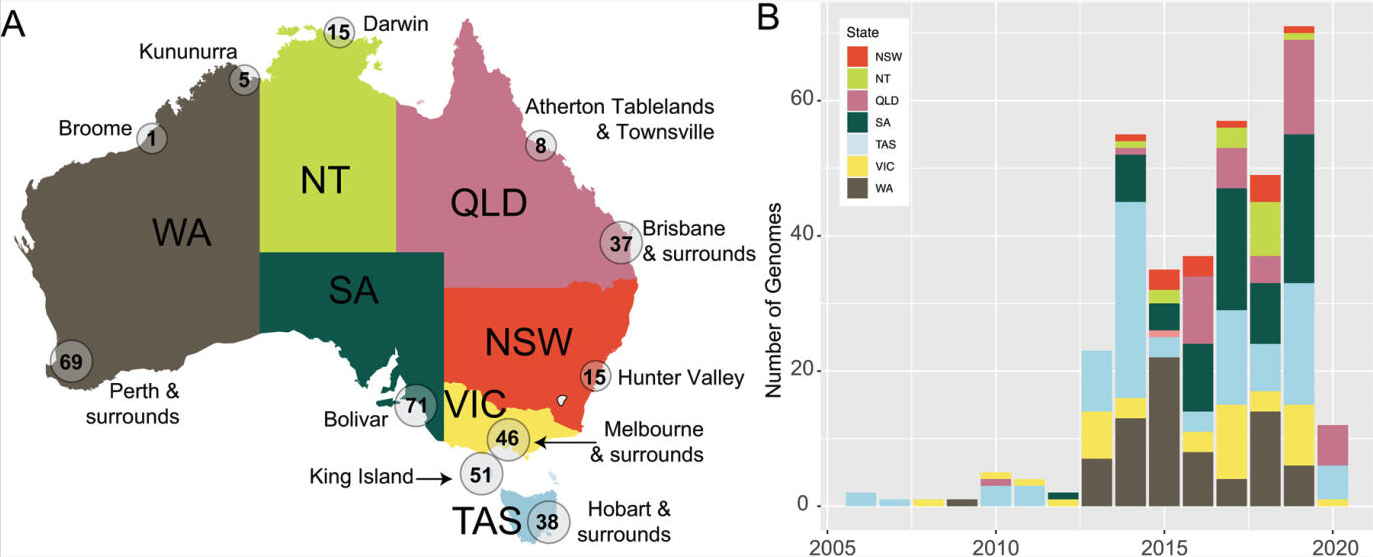Avian influenza virus (AIV) can cause a highly contagious viral disease that affects both domestic and wild birds. AIV can cause severe disease in poultry and can also occasionally cross-infect other non-avian species such as pigs and humans.
There are two categories of AIVs defined by their infection in poultry: low pathogenicity and high pathogenicity. The main natural reservoirs for low pathogenicity strains of AIV are wild waterfowl and to a lesser extent, shorebirds and gulls, with infection typically resulting in only mild or no clinical signs of disease in these birds. Low pathogenicity strains of AIV can spill over from wild bird populations into poultry where strains of H5 or H7 subtype have the potential to mutate into high pathogenicity viruses leading to severe disease and high mortality.
Data generated by the National Avian Influenza Wild Bird Surveillance (NAIWB) program, which screens samples from wild birds for AIV, is used to monitor and understand AIV dynamics in wild birds in Australia. Over the life of the 17-year program, thousands of wild bird samples have been screened with no high pathogenicity AIVs found in our wild birds. This program provides a contemporary source of AIV sequence data necessary to monitor the ongoing evolution of AIVs and ensure the performance of diagnostic tests applied to poultry and wild birds in Australia.
The most comprehensive (molecular epidemiological) study utilizing AIV data from wild birds generated through the NAIWB surveillance program to date is described in the paper, “Australia as a global sink for the genetic diversity of avian influenza A virus”, recently published in the journal PLoS Pathogens.
This publication draws upon many years of collaborative work undertaken through the NAIWB Surveillance partnership, utilising all of the available Australian wild bird AIV sequences generated by the CSIRO Australian Centre for Disease Preparedness (ACDP), World Health Organisation Collaborating Centre for Reference and Research on Influenza (WHOCCRI), Deakin University, and NAIWB participating state and territory governments and university laboratories; and incorporating all associated metadata.
The project was led by a partnership between WHOCCCRI, Deakin University, University of Sydney, and CSIRO ACDP in collaboration with WHA, the NAIWB Steering Group and NAIWB data providers. As part of the publication process, all corresponding Australian wild bird avian influenza sequences have been added to a global sequence data platform (GenBank), contributing to international collaborative sequence sharing.
This work shows that Australian AIVs are occasionally introduced from Eurasia. These virus lineages persist for varying lengths of time in isolation on the Australian continent with many eventually going extinct. The introduction of viruses to other continents from Australia is very rare. Hence Australia is a global sink for avian influenza virus diversity. Analysis of patterns in virus gene flow and infection dynamics within Australia was consistent with Australian wild waterfowl showing nomadic, rainfall-dependent movement patterns, and different to those observed in the northern hemisphere.

Creative Commons Spatial and temporal distribution of avian influenza genomes by Wille et. al. 2022 in 'Australia as a global sink for the genetic diversity of avian influenza A virus' is licensed under CC BY 4.0